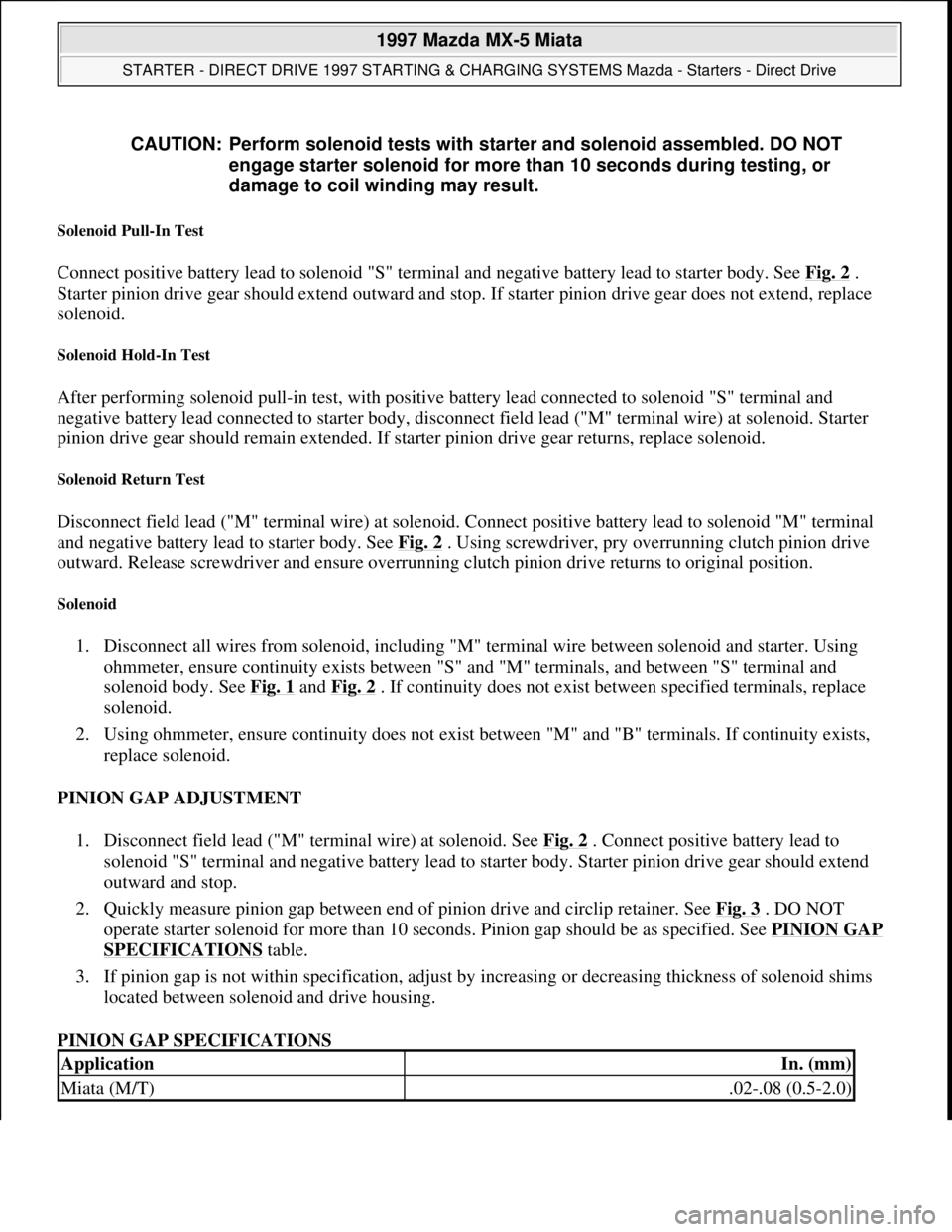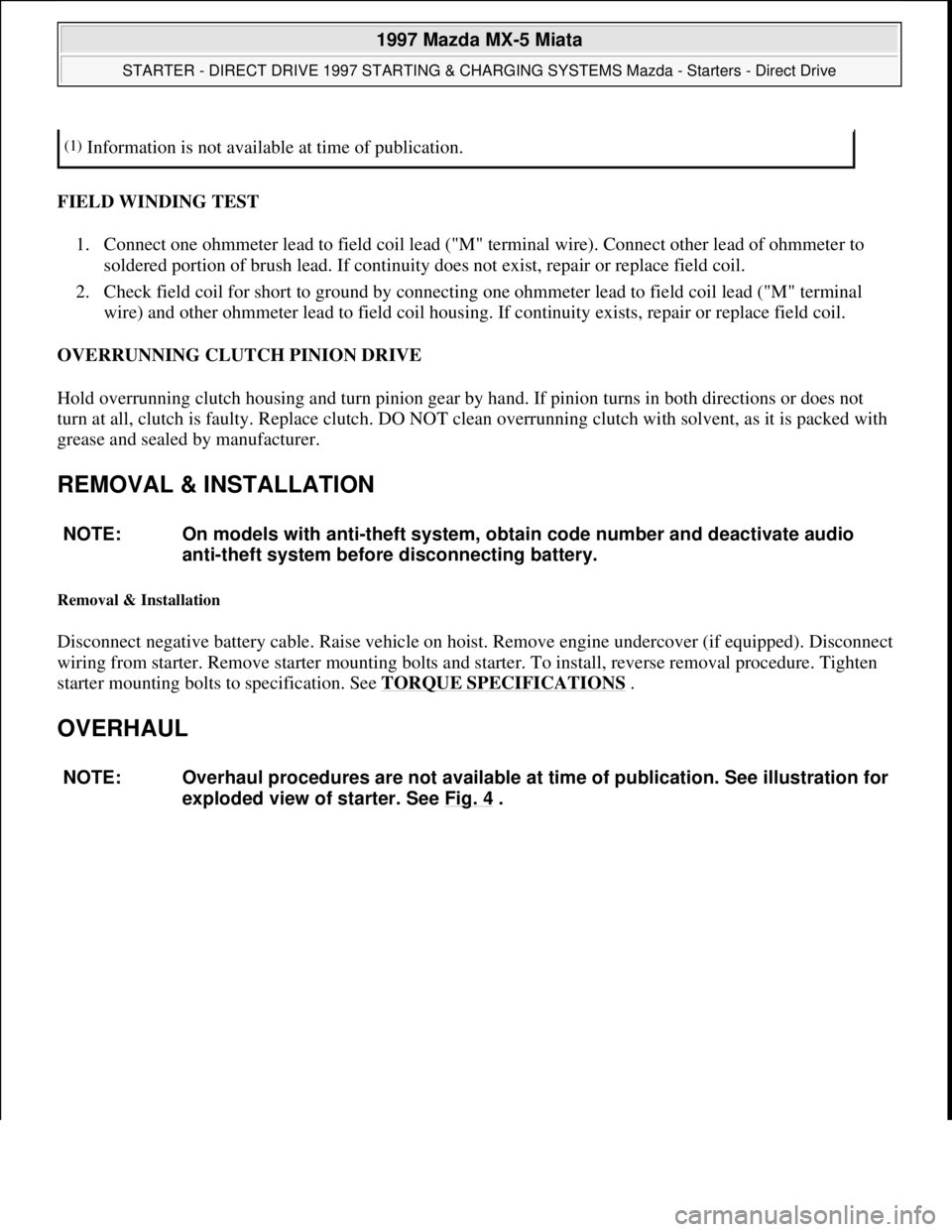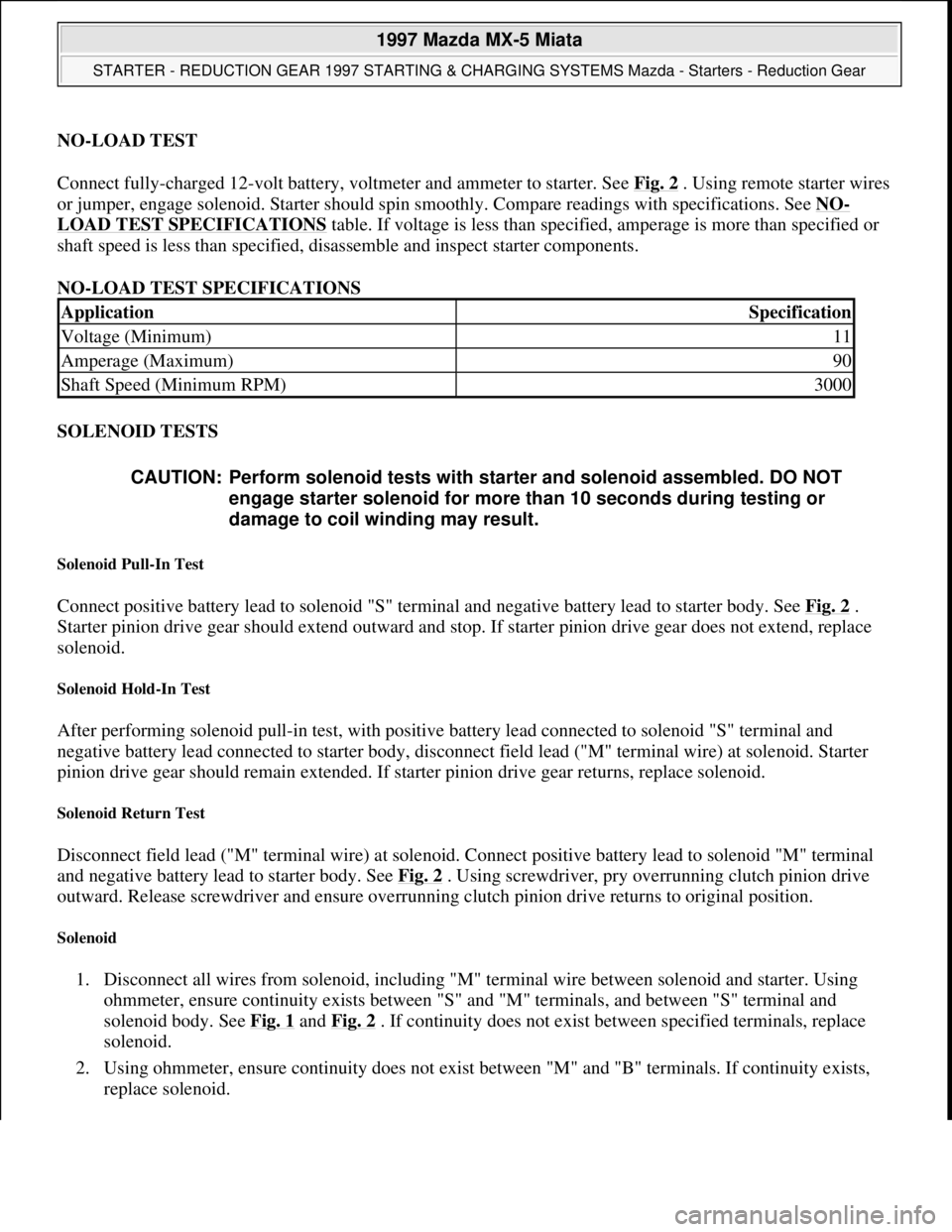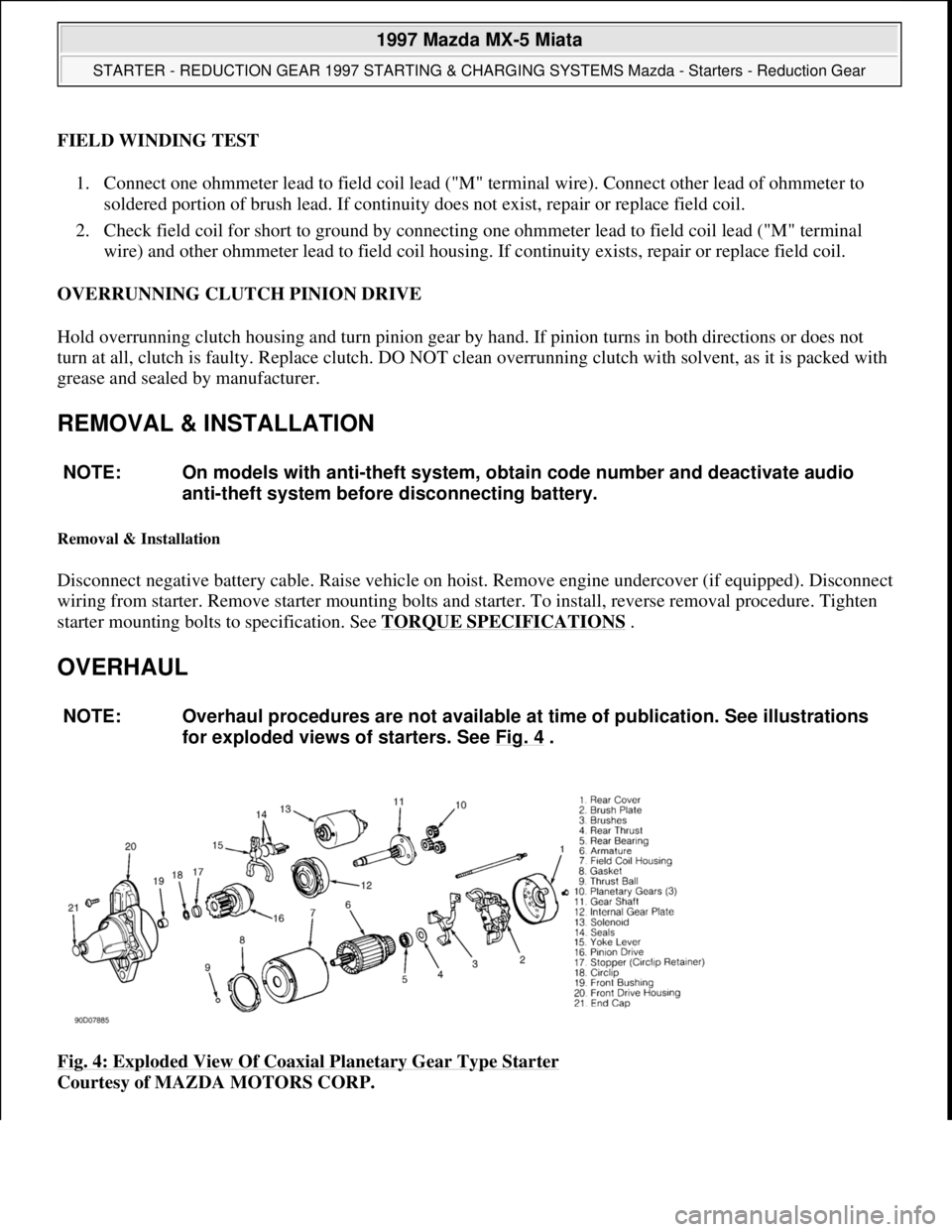Page 380 of 514

Solenoid Pull-In Test
Connect positive battery lead to solenoid "S" terminal and negative battery lead to starter body. See Fig. 2 .
Starter pinion drive gear should extend outward and stop. If starter pinion drive gear does not extend, replace
solenoid.
Solenoid Hold-In Test
After performing solenoid pull-in test, with positive battery lead connected to solenoid "S" terminal and
negative battery lead connected to starter body, disconnect field lead ("M" terminal wire) at solenoid. Starter
pinion drive gear should remain extended. If starter pinion drive gear returns, replace solenoid.
Solenoid Return Test
Disconnect field lead ("M" terminal wire) at solenoid. Connect positive battery lead to solenoid "M" terminal
and negative battery lead to starter body. See Fig. 2
. Using screwdriver, pry overrunning clutch pinion drive
outward. Release screwdriver and ensure overrunning clutch pinion drive returns to original position.
Solenoid
1. Disconnect all wires from solenoid, including "M" terminal wire between solenoid and starter. Using
ohmmeter, ensure continuity exists between "S" and "M" terminals, and between "S" terminal and
solenoid body. See Fig. 1
and Fig. 2 . If continuity does not exist between specified terminals, replace
solenoid.
2. Using ohmmeter, ensure continuity does not exist between "M" and "B" terminals. If continuity exists,
replace solenoid.
PINION GAP ADJUSTMENT
1. Disconnect field lead ("M" terminal wire) at solenoid. See Fig. 2
. Connect positive battery lead to
solenoid "S" terminal and negative battery lead to starter body. Starter pinion drive gear should extend
outward and stop.
2. Quickly measure pinion gap between end of pinion drive and circlip retainer. See Fig. 3
. DO NOT
operate starter solenoid for more than 10 seconds. Pinion gap should be as specified. See PINION GAP
SPECIFICATIONS table.
3. If pinion gap is not within specification, adjust by increasing or decreasing thickness of solenoid shims
located between solenoid and drive housing.
PINION GAP SPECIFICATIONS CAUTION: Perform solenoid tests with starter and solenoid assembled. DO NOT
engage starter solenoid for more than 10 seconds during testing, or
damage to coil winding may result.
ApplicationIn. (mm)
Miata (M/T).02-.08 (0.5-2.0)
1997 Mazda MX-5 Miata
STARTER - DIRECT DRIVE 1997 STARTING & CHARGING SYSTEMS Mazda - Starters - Direct Drive
Microsoft
Sunday, July 05, 2009 1:56:16 PMPage 5 © 2005 Mitchell Repair Information Company, LLC.
Page 383 of 514

FIELD WINDING TEST
1. Connect one ohmmeter lead to field coil lead ("M" terminal wire). Connect other lead of ohmmeter to
soldered portion of brush lead. If continuity does not exist, repair or replace field coil.
2. Check field coil for short to ground by connecting one ohmmeter lead to field coil lead ("M" terminal
wire) and other ohmmeter lead to field coil housing. If continuity exists, repair or replace field coil.
OVERRUNNING CLUTCH PINION DRIVE
Hold overrunning clutch housing and turn pinion gear by hand. If pinion turns in both directions or does not
turn at all, clutch is faulty. Replace clutch. DO NOT clean overrunning clutch with solvent, as it is packed with
grease and sealed by manufacturer.
REMOVAL & INSTALLATION
Removal & Installation
Disconnect negative battery cable. Raise vehicle on hoist. Remove engine undercover (if equipped). Disconnect
wiring from starter. Remove starter mounting bolts and starter. To install, reverse removal procedure. Tighten
starter mounting bolts to specification. See TORQUE SPECIFICATIONS
.
OVERHAUL
(1)Information is not available at time of publication.
NOTE: On models with anti-theft system, obtain code number and deactivate audio
anti-theft system before disconnecting battery.
NOTE: Overhaul procedures are not available at time of publication. See illustration for
exploded view of starter. See Fig. 4
.
1997 Mazda MX-5 Miata
STARTER - DIRECT DRIVE 1997 STARTING & CHARGING SYSTEMS Mazda - Starters - Direct Drive
Microsoft
Sunday, July 05, 2009 1:56:16 PMPage 8 © 2005 Mitchell Repair Information Company, LLC.
Page 391 of 514

NO-LOAD TEST
Connect fully-charged 12-volt battery, voltmeter and ammeter to starter. See Fig. 2
. Using remote starter wires
or jumper, engage solenoid. Starter should spin smoothly. Compare readings with specifications. See NO
-
LOAD TEST SPECIFICATIONS table. If voltage is less than specified, amperage is more than specified or
shaft speed is less than specified, disassemble and inspect starter components.
NO-LOAD TEST SPECIFICATIONS
SOLENOID TESTS
Solenoid Pull-In Test
Connect positive battery lead to solenoid "S" terminal and negative battery lead to starter body. See Fig. 2 .
Starter pinion drive gear should extend outward and stop. If starter pinion drive gear does not extend, replace
solenoid.
Solenoid Hold-In Test
After performing solenoid pull-in test, with positive battery lead connected to solenoid "S" terminal and
negative battery lead connected to starter body, disconnect field lead ("M" terminal wire) at solenoid. Starter
pinion drive gear should remain extended. If starter pinion drive gear returns, replace solenoid.
Solenoid Return Test
Disconnect field lead ("M" terminal wire) at solenoid. Connect positive battery lead to solenoid "M" terminal
and negative battery lead to starter body. See Fig. 2
. Using screwdriver, pry overrunning clutch pinion drive
outward. Release screwdriver and ensure overrunning clutch pinion drive returns to original position.
Solenoid
1. Disconnect all wires from solenoid, including "M" terminal wire between solenoid and starter. Using
ohmmeter, ensure continuity exists between "S" and "M" terminals, and between "S" terminal and
solenoid body. See Fig. 1
and Fig. 2 . If continuity does not exist between specified terminals, replace
solenoid.
2. Using ohmmeter, ensure continuity does not exist between "M" and "B" terminals. If continuity exists,
replace solenoid.
ApplicationSpecification
Voltage (Minimum)11
Amperage (Maximum)90
Shaft Speed (Minimum RPM)3000
CAUTION: Perform solenoid tests with starter and solenoid assembled. DO NOT
engage starter solenoid for more than 10 seconds during testing or
damage to coil winding may result.
1997 Mazda MX-5 Miata
STARTER - REDUCTION GEAR 1997 STARTING & CHARGING SYSTEMS Mazda - Starters - Reduction Gear
Microsoft
Sunday, July 05, 2009 1:56:43 PMPage 5 © 2005 Mitchell Repair Information Company, LLC.
Page 395 of 514

FIELD WINDING TEST
1. Connect one ohmmeter lead to field coil lead ("M" terminal wire). Connect other lead of ohmmeter to
soldered portion of brush lead. If continuity does not exist, repair or replace field coil.
2. Check field coil for short to ground by connecting one ohmmeter lead to field coil lead ("M" terminal
wire) and other ohmmeter lead to field coil housing. If continuity exists, repair or replace field coil.
OVERRUNNING CLUTCH PINION DRIVE
Hold overrunning clutch housing and turn pinion gear by hand. If pinion turns in both directions or does not
turn at all, clutch is faulty. Replace clutch. DO NOT clean overrunning clutch with solvent, as it is packed with
grease and sealed by manufacturer.
REMOVAL & INSTALLATION
Removal & Installation
Disconnect negative battery cable. Raise vehicle on hoist. Remove engine undercover (if equipped). Disconnect
wiring from starter. Remove starter mounting bolts and starter. To install, reverse removal procedure. Tighten
starter mounting bolts to specification. See TORQUE SPECIFICATIONS
.
OVERHAUL
Fig. 4: Exploded View Of Coaxial Planetary Gear Type Starter
Courtesy of MAZDA MOTORS CORP. NOTE: On models with anti-theft system, obtain code number and deactivate audio
anti-theft system before disconnecting battery.
NOTE: Overhaul procedures are not available at time of publication. See illustrations
for exploded views of starters. See Fig. 4
.
1997 Mazda MX-5 Miata
STARTER - REDUCTION GEAR 1997 STARTING & CHARGING SYSTEMS Mazda - Starters - Reduction Gear
Microsoft
Sunday, July 05, 2009 1:56:43 PMPage 9 © 2005 Mitchell Repair Information Company, LLC.